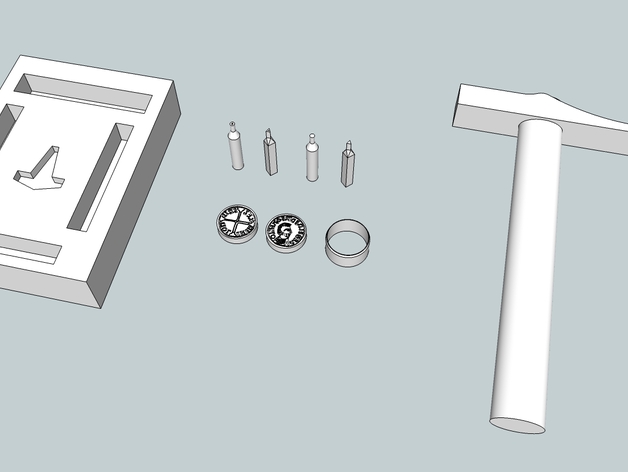
Viking Coin Striking set
thingiverse
This is the Viking Coin Striking set, complete with mold, punches, cutter, dies and hammer, all meticulously crafted after historical artifacts. You're invited to embark on a fascinating journey through the world of Vikings, trading, and silver! Complete your kit with a scale or other Viking artifacts by visiting my collection here: http://www.thingiverse.com/Snorri/collections/viking/page:1 Custom Section Overview & Background: With this project, you'll delve into the realm of currency during the Viking age, exploring the differences between bullion and coin-based economies, and how coins were struck. Objectives: * Acquire a basic understanding of Viking history * Grasp the distinction between bullion and coin-based economies * Master ancient metalworking and coin striking techniques Audiences: This project is tailored for children aged 8-13 years old. Subjects: History, Economy, Art Skills Learned: * History * Economy * Psychomotor skills Lesson/Activity: Bullion Economy For the teacher, a valuable resource can be found here: http://www.bbc.co.uk/history/ancient/vikings/money_01.shtml The silver is melted in a clay furnace using bellows, then poured into soapstone molds. Press a ball of clay into the mold to form an ingot or a Thor hammer. You can decorate the Mjolnir (Thor hammer) with punches, but be cautious not to strike too hard, as this would require real silver; putty suffices for a gentle tap. Now you can explain how ingots and silver objects were traded for their silver weight and could be mercilessly hacked to pieces or melted again. Coin-based Economy To create coins, begin by melting the silver, pouring it into the mold, and obtaining an ingot. However, something unique happens next. The silver ingot is struck repeatedly with a hammer to form a thin sheet. Blanks are cut using a circular cutter, then placed between two dies. Simulate this process with putty: cast it into a mold, flatten it with the hammer (frequently flipping it over to avoid sticking), and you'll face the same challenge as working with silver – achieving a flat surface requires skill. Cut a disk with the circular cutter, place the blank between the dies, and strike gently. You've now created your own Adelred Hiberno-Norse silver penny. The Cuerdale Hoard Fragments of Early Medieval Viking hacksilver from the Penrith area Viking Silver Ingots If you wish to continue your Viking journey, consider printing and using the foldable Viking scale I designed based on archeological pieces: http://www.thingiverse.com/thing:1646256 Other intriguing additions include: A Viking fortress: http://www.thingiverse.com/thing:1609498 A 3D-scanned Viking warrior: http://www.thingiverse.com/thing:1609582 A 3D-scanned Viking axe head: http://www.thingiverse.com/thing:1609633 A Viking boat (langskip): http://www.thingiverse.com/thing:1622713 A working Viking lock: http://www.thingiverse.com/thing:1630445 Viking art: http://www.thingiverse.com/thing:1622196http://www.thingiverse.com/thing:1622193http://www.thingiverse.com/thing:1609484
With this file you will be able to print Viking Coin Striking set with your 3D printer. Click on the button and save the file on your computer to work, edit or customize your design. You can also find more 3D designs for printers on Viking Coin Striking set.
